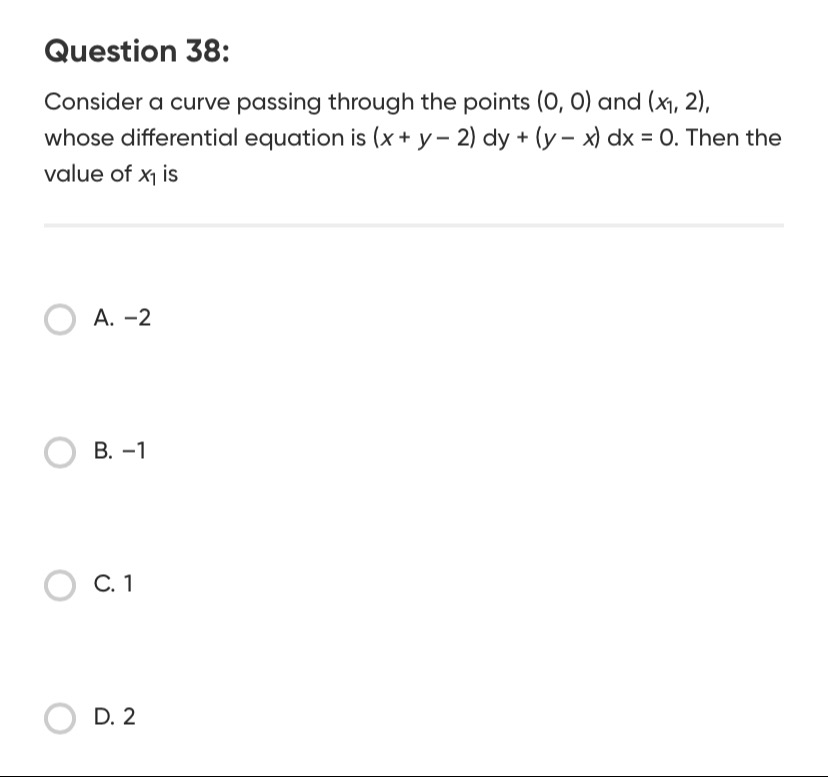Question
Question: Consider a curve passing through the points (0, 0) and ($x_1$, 2), whose differential equation is $(...
Consider a curve passing through the points (0, 0) and (x1, 2), whose differential equation is (x+y−2)dy+(y−x)dx=0. Then the value of x1 is

A
-2
B
-1
C
1
D
2
Answer
2
Explanation
Solution
The given differential equation is (x+y−2)dy+(y−x)dx=0. This can be rewritten as dxdy=x+y−2x−y. This is a non-homogeneous linear differential equation. We can make it homogeneous by a substitution. Let x=X+h and y=Y+k. Then dx=dX and dy=dY. Substituting these into the equation: ((X+h)+(Y+k)−2)dY+((Y+k)−(X+h))dX=0 (X+Y+h+k−2)dY+(Y−X+k−h)dX=0 To make this homogeneous, we need the constant terms to be zero:
- h+k−2=0
- k−h=0 From (2), k=h. Substituting into (1): h+h−2=0⟹2h=2⟹h=1. Thus, k=1. The substitution is x=X+1 and y=Y+1, which means X=x−1 and Y=y−1. The differential equation in terms of X and Y becomes: (X+Y)dY+(Y−X)dX=0 dXdY=X+YX−Y This is a homogeneous differential equation. Let Y=vX. Then dXdY=v+XdXdv. v+XdXdv=X+vXX−vX=1+v1−v XdXdv=1+v1−v−v=1+v1−v−v(1+v)=1+v1−2v−v2 Separating variables: 1−2v−v21+vdv=XdX Integrating both sides: ∫1−2v−v21+vdv=∫XdX The integral on the left is −21ln∣1−2v−v2∣. So, −21ln∣1−2v−v2∣=ln∣X∣+C1 ln∣1−2v−v2∣−1/2=ln∣X∣+C1 1−2v−v21=A∣X∣ where A=eC1 Squaring both sides: 1−2v−v21=A2X2 1=A2X2(1−2XY−X2Y2) 1=A2(X2−2XY−Y2) X2−2XY−Y2=C′ where C′=1/A2. Substituting back X=x−1 and Y=y−1: (x−1)2−2(x−1)(y−1)−(y−1)2=C′ The curve passes through (0, 0). Substitute x=0,y=0: (−1)2−2(−1)(−1)−(−1)2=C′ 1−2−1=C′⟹C′=−2. The equation of the curve is (x−1)2−2(x−1)(y−1)−(y−1)2=−2. The curve passes through (x1, 2). Substitute x=x1,y=2: (x1−1)2−2(x1−1)(2−1)−(2−1)2=−2 (x1−1)2−2(x1−1)(1)−(1)2=−2 (x1−1)2−2(x1−1)−1=−2 Let Z=x1−1. Then Z2−2Z−1=−2⟹Z2−2Z+1=0. This factors as (Z−1)2=0, so Z=1. Substituting back Z=x1−1, we get x1−1=1, which means x1=2.
